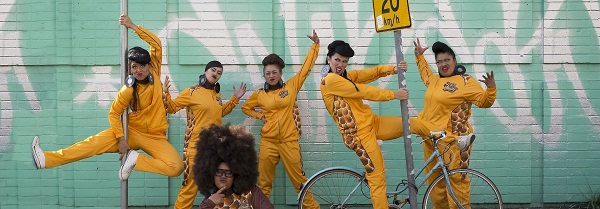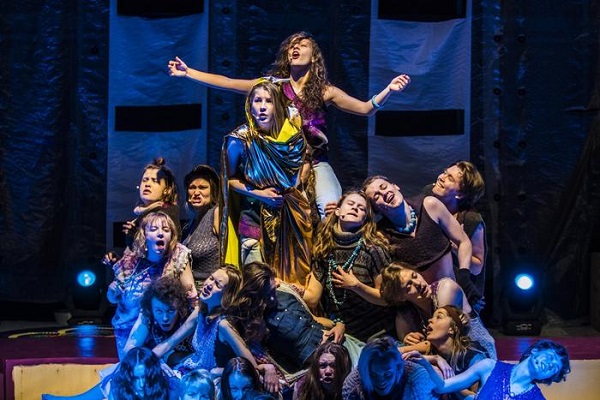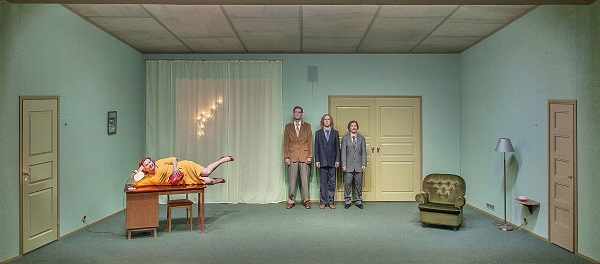The largest theatre festival in the Nordic countries, the Tampere Theatre Festival, was defined during summer 2019 by performances that “challenge the perceived balance between things, break the norms, counter racism in any of its forms and rewrite history.” The three-member artistic group responsible for the program chose the name “On the Knife’s Edge. Theatre of Bravery and Danger.” The festival was successful in fulfilling the said promise, though, the line between safe and dangerous proved to be hard to determine and was not experienced by the majority. During the festival, which was once created to serve as a look into the Finnish theatre scene, domestic and foreign performances were now represented in equal measure, all of which were ambitious and versatile in their attempts to take a stand on societal phenomena.

Hot Brown Honey, performed by the Australian Briefs Factory. Photo: courtesy Tampere Theatre Festival.
Due to the long timetable, the foreign repertoire was chosen before the domestic, and this influenced the Finnish performance choices. Hot Brown Honey, performed by the Australian Briefs Factory, proved that there are many ways to shock the audience. Different preconceptions were sent spinning, and the performance also enhanced the feminist theme present in the repertoire. The La Reprise, directed by Milo Rau, tested the line between performing and reality. Through its multinational background, the performance showed that violence and traumas have no borders. Many of the other foreign performances also explored identity and the multi-cultural society. Domestic performances shared these same themes and subject matters.
During the early years of the festival, the highest-rated Finnish productions of the prior season were invited to Tampere, and performances were rewarded on different grounds. These days, rather than providing an overall view on the best of the Finnish theatre, the modern festival aims to push the boundaries of theatrical expression. The respect and interest the theatre-folk have shown towards the festival are still present, as was assessed by Tanja-Riitta Räikkä, who started in the three-person artistic management team. As a founding member of the theatre group Telakka, which originates from Tampere, and as someone who has performed multiple times in the festival, she has experienced the past as a member of the audience, theatre director, as someone from Tampere, and now as a member of the management team. Although these days the national representation is not the main focus in choosing the performances, this year’s festival once again had characteristics commonly found within the Finnish theatre: theatre has been affected by the society in a new way, all modes of performing exist side by side and mixed up, and even the traditional theatres have opened their doors to not only visiting companies but also to artistic co-operation, and shifting casts have shifted between different forms of theatre.

Hair, performed by Tampere Pop Theatre. Photo: courtesy Tampere Theatre Festival.
The opening performance of the festival, Hair, a collaborative production between the Finnish theatre academies, was a reminder of the early days of Tampere’s theatre festival, of the shocking summer 1969 Hair-performance by Tampere Pop Theatre, and of the additional color gained through its Woodstock-like reputation. A piece written by a student at the theatre Academy, Geoffrey Eristan, N.E.G.R.O, argued that times had nevertheless changed during the decades. Eristan, who had come to Finland from Africa as a child, says that onstage he reflects his black masculinity through African masculinity. His immediate impulse to formulating the thesis was international and discovered in Berlin, where during a study trip, Finnish Theatre Academy students were awakened to a novel abundance of different stage bodies. In the festival’s repertoire, Eristan’s brave analysis represented the line of repeatedly finding and presenting identity, similar to what Keisha Thomson, a British visitor, accomplished in her monologue Man on the Moon. The diversity of bodies is still limited within the Finnish theatre scene and often presented only by visiting performances, hence Eristan’s thrilling performance brought with it at least a temporary change in this situation. What made the performance brave was the Finnish cultural context.
The Finnish National Theatre’s play based on the novel by Pajtim Statovci, My Cat Yugoslavia, followed the theme of searching for an identity. The performance, directed by Johanna Freundlich, depicted the life of a young man in both Kosovo and Finland, his adjustment to the country, culture, and his own body. Eva Buchwald’s dramaturgy contributed greatly to the scenic success of the multi-layered narrative. The play touched on the European questions of war and refugees, and although the situation in Kosovo can be considered a part of recent history, the continuity to modern times that began there ensured the feeling of contemporariness. My Cat Yugoslavia was a performance by men: Toni Harjajärvi as a young man, Petri Liski and Ville Tiihonen alternating between roles of symbolic animals and males. Sari Puumalainen acted as a mirror image by portraying the story of a Kosovan woman and mother.
The play performed by Q-Teatteri, Medusa’s Room, and written and directed by Saara Turunen, has been one of Finland’s most discussed performances in 2019. The name of the play emphasized the central theme of the performance. The writer, stirred by Hèléne Cixous’s essay, was shocked when it was revealed that the Medusa myth actually depicts the consequences of rape in men, rather than the violation of a woman. The play illustrated how men rule the room built on stage. For example, in one short scene, the female narrator’s written reference to the need for a personal room was greatly overshadowed when the men filled the space by picking out one substantial male character after another from the literary and drama classics. The message the play had was clear and simple, but its joyous theatrical performing required insight from the spectator. The gender presentation also varied, as did the range of bodies, which highlighted the message instead of the story and guided the spectator to ponder on the repetitive nature of discriminative practices.
The conversation surrounding the harassment females face has been active also in Finland and emphasized among the movie and theatre circles. Medusa’s Room is not an exception to the rule, but by having a myth as the foundation, the perform

Medusa’s Room, written and directed by Saara Turunen. Photo: courtesy Tampere Theatre Festival.
ance was able to remove itself from the individual-centric nature of public discourse and introduce more hidden elements of discrimination that exist in normal day-to-day life. The actors skillfully expressing their characters in Janina Rajakangas’ choreography, Elina Knihtilä, Tommi Korpela, Katja Kütner, Aksinja Lommi and Ylermi Rajamaa, preserved the narrative mode within the theatrical repetition of different attitudes. During the cheerful action, the audience was introduced, to seemingly innocent-looking attitudes that hid their discriminative nature by being in constant practice. The performance brought a fresh perspective into the public discourse – without losing the critical message.
Co-operation between theatres was seen in many of the festival’s performances. Bilingual Finland’s three small Swedish theatres, Klockriketeatern, Sirius Teatern and Teater Mestola, performed Marat / Sade by Peter Weiss. The play holds a significant place in the Finnish theatre’s recent history, though, once again, time seems to have changed how it is read. Juha Hurme’s interpretation resembled the director’s distinctive and carnival-styled works, rather than the cult performances of Brecht, Artaud, and others working in the style of 1960’s societal discourse. There were no signs of politics in the program nor in the advertising. The anarchy was untamable – maybe on purpose. The play was performed in Swedish. During the spring, it had been translated into a Finnish-language performance also. In addition to this, Mikko Roiha’s directorial work of Mari Jotuni’s classic Finnish play, Man’s Rib, was a joint production between seven theatres. Roiha, who partly works in Berlin, has a long career as a director and experience in co-operation between different theatres. The successful flow of the whole can be traced to his ability to condense the text and stylize the work of actors with different theatrical backgrounds. Jotuni, a modern master of drama, was up to the challenge. Her lines on the brutality of the female position and on the challenge of recognizing these situations came to life on stage. Femininity and women’s position was also explored through another classic; in a play directed by Alma Lehmuskallio, Nora, wherein Rosanna Kemppi and Kreeta Salminen commented through their interpretations on the world of Ibsen’s text.
The repertoire of Tampere’s Theatre Summer showed that this political orientation, wide in its expression and point of view, had gotten even stronger in Finnish theatres. The state of society was commented on also through both dance and clowning. Being different was a commonality between the performances, and despite the strong position of Helsinki, a geographical variance was clearly visible. The emphasized position of the actor was seen through solo performances.
Despite this political orientation, the re-reading of history had only a minor part within the festival performances, even though this subject has been otherwise quite visible in Finnish theatres. The 100th anniversary of the Finnish Civil War waged in 1918 was examined on multiple stages during the preceding year. After this serious subject matter, many of the last season’s historical depictions had a strong metatheatrical stand. Lea by KOM-teatteri was an explosive performance based on contemporary research of the alleged preparations involved with the first Finnish-language theatre play, which was also marked by the carnivalistic touch of the director Juha Hurme. The Finnish national author, Aleksis Kivi, got fresh blood into his veins, and the theatre group built tenderly ironic images of recognizable historical individuals. The Artistic Director of the Esbo International Theatre of Finland, Erik Söderblom, directed, in turn, a community theatre performance, which concentrated on a series of key events in Finnish history, wherein the strong presence of amateur performers impressively proved how today was built by history. Doghill’s Finnish History, performed by the Finnish National Theatre, was aimed at children and was a look into the centuries Finland spent as a part of Sweden. Within the performance, directed by Irene Aho, the strong actors of the theatre captured the animal characters from Mauri Kunnas’ popular book in a style suitable for great historical dramas – with the same rigor and skill of characterization.
Professor Emerita Pirkko Koski was responsible for the Department of Theatre Research in the Institute of Art Research at the University of Helsinki, and the director of the Institute of Art Research until the end of 2007. Her research concentrates on performance analysis, historiography, and Finnish theatre and its history. She has also edited several anthologies about Finnish theatre, and volumes of scholarly articles translated into Finnish.

European Stages, vol. 14, no. 1 (Fall 2019)
Editorial Board:
Marvin Carlson, Senior Editor, Founder
Krystyna Illakowicz, Co-Editor
Dominika Laster, Co-Editor
Kalina Stefanova, Co-Editor
Editorial Staff:
Stephen Cedars, Assistant Managing Editor
Dohyun Gracia Shin, Assistant Managing Editor
Advisory Board:
Joshua Abrams
Christopher Balme
Maria Delgado
Allen Kuharsky
Bryce Lease
Jennifer Parker-Starbuck
Magda Romańska
Laurence Senelick
Daniele Vianello
Phyllis Zatlin
Table of Contents:
- The 73rd Avignon Festival, July 4-23, 2019 : Odysseys, past, present and future by Philippa Wehle.
- Ibsen in London by Marvin Carlson.
- Report from London (November – December, 2018) by Dan Venning.
- It’s All in the Wrist: How Nina Conti Faces Off with Reality by Katy Houska.
- Staging Trauma: A Review of Bryony Kimmings’s I’m a Phoenix, Bitch by Rachel Anderson-Rabern.
- Difficult Pasts and Revivals: Madrid Theatre Summer 2019 by Maria M. Delgado.
- Cultural Diversity in the Kunstenfestivaldesarts (Brussels) 2019 by Manuel García Martínez.
- Tampere Theatre Festival: Progressing Society by Pirkko Koski.
- NASZA KLASA in Georgia by Mikheil Nishnianidze.
- Young and Critical Voices of Turkey I: “Theatre helps us to hear each other.” A Conversation with Irem Aydın by Eylem Ejder.
www.EuropeanStages.org
europeanstages@gc.cuny.edu
Martin E. Segal Theatre Center:
Frank Hentschker, Executive Director
Marvin Carlson, Director of Publications
©2019 by Martin E. Segal Theatre Center
The Graduate Center CUNY Graduate Center
365 Fifth Avenue
New York NY 10016
European Stages is a publication of the Martin E. Segal Theatre Center ©2019
Martin E. Segal Theatre Center:
Frank Hentschker, Executive Director
Marvin Carlson, Director of Publications
©2019 by Martin E. Segal Theatre Center
The Graduate Center CUNY Graduate Center
365 Fifth Avenue
New York NY 10016
European Stages is a publication of the Martin E. Segal Theatre Center ©2019



